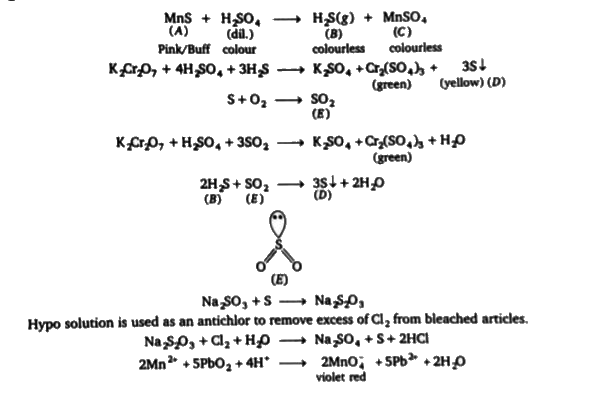A coloured compound (A) reacts with dilute H2SO4 to produce a colourless gas (B) and colourless solution (C). The reaction between (B) and the acidified K2Cr2O7 solution produces a green solution and a slightly yellowish precipitate (D). the substance (D) burns in air to produce a gas (E) which also cann change the colour of K2Cr2O7 solution.
Q. "A" probably, is:
ZnSO3
CoS
MnS
NiS
The correct Answer is:C
Topper's Solved these Questions
- QUALITATIVE INORGANIC ANALYSISBOOK - VK JAISWALCHAPTER - QUALITATIVE INORGANIC ANALYSISEXERCISE - ONE OR MORE ANSWER IS/ARE CORRECT
45 Videos
- QUALITATIVE INORGANIC ANALYSISBOOK - VK JAISWALCHAPTER - QUALITATIVE INORGANIC ANALYSISEXERCISE - MATCH THE COLUMN
2 Videos
- QUALITATIVE INORGANIC ANALYSISBOOK - VK JAISWALCHAPTER - QUALITATIVE INORGANIC ANALYSISEXERCISE - LEVEL 2
75 Videos
- PERIODIC PROPERTIESBOOK - VK JAISWALCHAPTER - PERIODIC PROPERTIESEXERCISE - ASSERTION-REASON TYPE QUESTIONS
35 Videos
- s-BLOCK ELEMENTSBOOK - VK JAISWALCHAPTER - s-BLOCK ELEMENTSEXERCISE - SUBJECTIVE PROBLEMS
2 Videos
Similar Questions
A white substance (A) reacts with dilute H2SO4 to produce a colourless gas (B) and a colourless solution (C).The reaction between (B) and acidified K2Cr2O7 solution produces a green solution and a slightly coloured precipitate (D).The substance (D) burns in air to produce a gas (E) which reacts with (B) to yield (D) and a colourless liquid. Anhydrous copper sulphate is turned blue on addition of this colouless liquid.Addition of aqueous NH3 or NaOH to (C) produces first a white precipitate which dissolves in the excess of the respective reagent to produce a clear solution in each case. Identify (A),(B),(C),(D) and (E).
View SolutionA coloured compound (A) reacts with dilute H2SO4 to produce a colourless gas (B) and colourless solution (C). The reaction between (B) and the acidified K2Cr2O7 solution produces a green solution and a slightly yellowise precipitate (D). the substance (D) burns in air to produce a gas (E) which also can change the colour of K2Cr2O7 solution.
Q. When "B" reacts with "E"
View Solution
Knowledge Check
A coloured compound (A) reacts with dilute H2SO4 to produce a colourless gas (B) and colourless solution (C). The reaction between (B) and the acidified K2Cr2O7 solution produces a green solution and a slightly yellowise precipitate (D). the substance (D) burns in air to produce a gas (E) which also can change the colour of K2Cr2O7 solution.
Q. "A" probably, isAZnSO3BCoSCMnSDNiSA coloured compound (A) reacts with dilute H2SO4 to produce a colourless gas (B) and colourless solution (C). The reaction between (B) and the acidified K2Cr2O7 solution produces a green solution and a slightly yellowish precipitate (D). the substance (D) burns in air to produce a gas (E) which also cann change the colour of K2Cr2O7 solution.
Q. When "B" racts with "E":Aa new gas F will be producedBIt produced D and a colourless liquidCthere will be no reaction between themDit yields B and an acidic oxieA coloured compound (A) reacts with dilute H2SO4 to produce a colourless gas (B) and colourless solution (C). The reaction between (B) and the acidified K2Cr2O7 solution produces a green solution and a slightly yellowish precipitate (D). the substance (D) burns in air to produce a gas (E) which also cann change the colour of K2Cr2O7 solution.
Q. Which is not correct about E ?AIt is colourless and highly water solubleBThe molecule is linearCIts aqueous solution acidicDit turns starch iodate paper blue
A coloured compound (A) reacts with dilute H2SO4 to produce a colourless gas (B) and colourless solution (C). The reaction between (B) and the acidified K2Cr2O7 solution produces a green solution and a slightly yellowish precipitate (D). the substance (D) burns in air to produce a gas (E) which also cann change the colour of K2Cr2O7 solution.
Q. When colourless solution (C) reacts with Pb3O4/H+, it acquries a violet red colour due to formation of :
View SolutionA coloured compound (A) reacts with dilute H2SO4 to produce a colourless gas (B) and colourless solution (C). The reaction between (B) and the acidified K2Cr2O7 solution produces a green solution and a slightly yellowise precipitate (D). the substance (D) burns in air to produce a gas (E) which also can change the colour of K2Cr2O7 solution.
Q. When colourless solution (C) reacts with Pb3O4/H+, it acquires a violet red colour due to formation of
View SolutionA coloured compound (A) reacts with dilute H2SO4 to produce a colourless gas (B) and colourless solution (C). The reaction between (B) and the acidified K2Cr2O7 solution produces a green solution and a slightly yellowish precipitate (D). the substance (D) burns in air to produce a gas (E) which also cann change the colour of K2Cr2O7 solution.
Q. When D is boiled with alkaline sulphite solution a compound F is formed. F can be used in
(I) Iodine titrations in volumetric analysis
(II) Bleaching industry to destroy excess Cl2
(III) Photography for 'fixing' films
(IV) Iodometric titrations
Choose the correct codes:
View SolutionA coloured compound (A) reacts with dilute H2SO4 to produce a colourless gas (B) and colourless solution (C). The reaction between (B) and the acidified K2Cr2O7 solution produces a green solution and a slightly yellowise precipitate (D). the substance (D) burns in air to produce a gas (E) which also can change the colour of K2Cr2O7 solution.
Q. When D is boiled with alkaline sulphite solution a compound F is formed. F can be used in
(I) Iodine titrations in volumetric analysis
(II) Bleaching industry to destroy excess Cl2
(III) Photography for 'fising' films
(IV) Iodometric titrations
Choose the correct codes
View SolutionA coloured compound (A) reacts with dilute H2SO4 to produce a colourless gas (B) and colourless solution (C). The reaction between (B) and the acidified K2Cr2O7 solution produces a green solution and a slightly yellowise precipitate (D). the substance (D) burns in air to produce a gas (E) which also can change the colour of K2Cr2O7 solution.
Q. Which is not correct about E
View Solution

